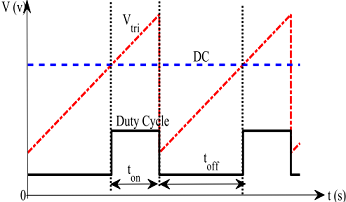Effect of Duty Cycle Control on Performance of Sepic DC – DC Buck-Boost Converter under Resistive Load Applications
DOI:
https://doi.org/10.62050/ljsir2025.v3n1.488Keywords:
Sepic converter, Duty cycle, Resistive load, Voltage controlAbstract
This paper investigates the effect of duty cycle control on the performance of the SEPIC (Single-Ended Primary Inductor Converter) DC–DC buck-boost converter, particularly when subjected to resistive load applications. The SEPIC converter, known for its ability to output a voltage either greater or lesser than the input, finds broad application in power supplies and renewable energy systems. An analysis of how the duty cycle influences key performance metrics—such as output voltage, currents and voltage ripple is presented. Simulation result demonstrate that careful modulation of the duty cycle enables optimization of converter performance, offering valuable insights into how these converters can be tuned to enhance efficiency in resistive load scenarios. The results obtained reveal that the Sepic dc dc converter is capable of delivering a maximum output power approximately 1857W at duty cycle of 80 % with 20 kHz switching frequency. Also, at the same switching frequency, 20 % duty cycle, a minimum output power of approximately 5.34 W was obtained. These insights are valuable for power electronics engineers seeking to optimize SEPIC converters for domestic load applications.
Downloads
References
Padhi, B. K. and Narain, A. (2013). Controller Design for Sepic Converter Using Model Order Reduction. International Journal of Electrical, Electronics and Data Communication (IJEEDC), 1(3). 19 – 24.
Padhi, B. K., Padhy S. N. and Bhuyan K. C. (2016). Controller design for reduced order model of SEPIC Converter. 2016 International Conference on Signal Processing, Communication, Power and Embedded System (SCOPES), Paralakhemundi, India, 1533 – 1538. https://doi.org/10.1109/SCOPES.2016.7955696.
Ismail, A. A. and Elnady, A. (2019). Advanced Drive System for DC Motor Using Multilevel DC/DC Buck Converter Circuit. IEEE Access, 7, 54167-54178. https://doi.org/101109/ACCESS.2019.2912315.
Kamat, S. and Jadhav, S. (2019). Design and Simulation of Low Power Charging Station for Electric Vehicle. 2019 International Conference on Advances in Computing, Communication and Control (ICAC3), Mumbai, India, 1- 4. https://doi.org/10.1109/ICAC347590.2019.9036771.
Hu, K. Chen, Y. Lin, H. and Tsai, C. (2018). Digital Buck Converter with Adaptive Driving Circuit for Cascade Power MOS. 2018 IEEE 7th Global Conference on Consumer Electronics (GCCE), Nara, Japan, 291-292. https://doi.org/10.1109/GCCE.2018.8574858.
Yadlapalli, R. T. and Kotapati, A. (2017). Efficiency analysis of Quadratic buck converter for LED lamp driver applications. 2017 International Conference on Trends in Electronics and Informatics (ICEI), Tirunelveli, India, 210-214. https://doi.org/10.1109/ICOEI.2017.8300917.
Rigogiannis, N., Baros, D., Lempesis, E., Ntoga, S., Peiogluou, E. and Pechlivanis C. (2019). Experimental Investigation of a Digitally Current Controlled Synchronous Buck DC/DC Converter for Microgrids Applications. 2019 Panhellenic Conference on Electronics & Telecommunications (PACET), Volos, Greece, 1-5. https://doi.org/10.1109/PACET48583.2019.8956274.
Patil, A. A., Chavan D. S. and Yadav S. V. (2016). Output voltage control scheme for standalone wind energy system. 2016 International Conference on Computation of Power, Energy Information and Communication (ICCPEIC). Melmaruvathur, India, 534-541. https://doi.org/10.1109/ICCPEIC.2016.7557290.
Pal, K. and Pattnaik, M. (2019). Performance of a Synchronous Buck Converter for a Standalone PV System: An Experimental Study. 2019 IEEE 1st International Conference on Energy, Systems and Information Processing (ICESIP), Chennai, India, 1-6. https://doi.org/10.1109/ICESIP46348.2019.8938345.
Fei, C. Ahmed, M. H. Lee, F. C. and Li, Q. (2017). Two-Stage 48 V-12 V/6 V- 1.8 V Voltage Regulator Module with Dynamic Bus Voltage Control for Light-Load Efficiency Improvement. IEEE Transactions on Power Electronics, 32(7): 5628-5636. https://doi.org/10.1109/TPEL.2016.2605579.
Sucu, H., Goktas, T. and Arkan, M. (2021). Design, Simulation and Application of Buck Converter with Digital PI Controller. Balkan Journal of Electrical and Computer Engineering, 9(2), 106 – 113. https://doi.org/10.17694/bajece.884290.
Mohamed H. A., Khattab, H. A., Mobarka A. and Morsy A. (2016). Design, Control and Performance analysis of DC – DC boost Converter for stand-alone PV System. 2016 Eighteenth international Middle East Power Systems Conference (MEPCON), Cairo, Egypt, 101 – 106. https://doi.org/10.1109/MEPCON.2016.7836878.
Arulmurugan, R. and Vanitha, N. S. (2012). Optimal design of dc-dc boost converter with closed loop control PID mechanism for high voltage photovoltaic application. International Journal of Power Electronics and Drive System (IJPEDS), 2(4), 434 – 444. https://doi.org/1011591/ijpeds.v2i4.2126.
Sathya, P. and Natarajan, R. (2013). Design and Implementation of 12V/24V Closed loop Boost Converter for Solar Powered LED Lighting System. International Journal of Engineering and Technology (IJET), 5(1), 254 – 264.
Asad, M. M., Hassan, R. B. and Sherwani, F. (2014). An Analytical Comparison between Open Loop, PID and Fuzzy Logic Based DC-DC Boost Converter. International Journal of Electrical, Computer, Energetic, Electronic and Communication Engineering. 8(11), 1696 – 1701.
Dave, M. R. and Dave, K. C. (2012). Analysis of Boost Converter Using PI Control Algorithms. International Journal of Engineering Trends and Technology, 31(2), 71 -73.
Diyoke, G. C. and Onwuka, I. K. (2015). Mathematical Analysis and simulation of Cuk’s DC to DC Converter: Teaching and Research. Umudike Journal of Engineering and Technology (UJET), 1(2): 125 – 136.
Sousa, S. M., Leite, V. J. S., Fernandes, S. W. and Oliveira, I. R. H. (2019). SEPIC DC/DC converter control by observed-state feedback. 2019, IEEE 15th Brazilian Power Electronics Conference (COBEP/SPEC). Santos, Brazil, 1-6. https://doi.org/10.1109/COBEP/SPC44138.2019.9065496.
Ebrahim, E. (2014). Calculation of Output Voltage Ripple and Design Consideration of SEPIC Converter. IEEE Transactions on Industrial Electronics, 61(3), 1213 – 1222. https://doi.org/10.1109/TIE.2013.2262748.
Swathy, M. K., Jantre, M. S., Jadhav, M. Y., Labde, M. S. M. and Kadam, M. P. (2018). Design and Hardware Implementation of Closed Loop Buck Converter Using Fuzzy Logic Controller. 2018 Second International Conference on Electronics, Communication and Aerospace Technology, Coimbatore, India, 175 – 180. https://doi.org/10.1109/ICECA.2018.8474570.

Downloads
Published
Issue
Section
License
Copyright (c) 2025 Lafia Journal of Scientific and Industrial Research

This work is licensed under a Creative Commons Attribution-NonCommercial-ShareAlike 4.0 International License.









